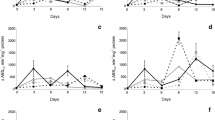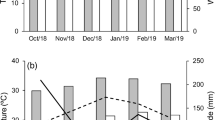Summary
The level of Azospirillum brasilense strain Cd colonization in the rhizosphere of some vegetables was 104–105 colony-forming units (CFU) per root of one plant in 2-week-old plants inoculated with 5 × 108 Azospirillum cells. Significant increases in root length (35%) and in top (90%) and root (50%) dry weight and total leaf area (90%) were observed in 18-day-old inoculated tomato plants compared with non-inoculated controls. An inoculum concentration of 1 × 108 to 5 × 108 CFU/ml stimulated the appearance of root hairs. Large numbers of bacteria (1 × 109 CFU/ml) caused asymmetrical growth of the root tip. In a petri dish system, Azospirillum (1 × 108 CFU/ml) increased root dry weight (150%), protein content (20%), respiration rate per root (70%) and the specific activity of malate dehydrogenase (45%–65%) over non-inoculated controls. The specific respiration rate, expressed as micromol of O2 per minute per milligram of dry weight of roots, was significantly lower in inoculated roots, suggesting that less energy was spent for accumulation of more dry material.
Similar content being viewed by others
References
Bowen GD, Rovira AD (1961) The effect of microorganisms on plant growth. Plant Soil 15:166–188
Brown ME (1974) Seed and root bacterization. Annu Rev Phytopathol 12:181–197
Burr TJ, Caesar A (1984) Beneficial plant bacteria. Crit Rev Plant Sci 2:1–20
Chang Y, Chang Y, Baker R, Kleifeld O, Chet I (1985) Increased growth of plant induced by the biological control agent, Trichoderma harzianum. Plant Dis 70:145–148
Cook RJ, Baker KF (1983) The nature and practice of biological control of plant pathogens. The American Phytopathological Society, St Paul, Minn, p 539
Gafny R, Okon Y, Kapulnik Y, Fischer M (1986) Adsorption of Azospirillum brasilense to corn roots. Soil Biol Biochem 18:69–75
Goodman RN, Kiraly Z, Wood KR (1986) The biochemistry and physiology of plant disease. University of Missouri Press, Columbia, p 433
Hadas R, Okon Y, Elad Y, Chet I (1986) Plant growth promoting effects of Azospirillum brasilense on bean, melon, cucumber and tomato seedlings. Phytoparasitica 14:255 (Abstr)
Hartmann A, Fuseder A, Klingmuller W (1983) Mutants of Azospirillum affected in nitrogen fixation and auxin production. In: Klingmuller W (ed) Azospirillum II. Genetics, physiology, ecology. Birkhäuser, Basel, pp 78–87
Kapulnik Y, Gafny R, Okon Y (1985) Effect of Azospirillum spp. inoculation on root development and NO3 uptake in wheat (Triticum aestivum cv. Miriam) in hydroponic systems. Can J Bot 63:627–631
Kloepper JW, Schroth MN (1981) Plant growth promoting rhizobacteria and plant growth under gnotobiotic conditions. Phytopathology 71:642–644
Kloepper JW, Leong J, Teintze T, Schroth MN (1980) Enhanced plant growth by siderophores produced by plant growth promoting rhizobacteria. Nature 286:885–886
Lin W, Okon Y, Hardy RWF (1983) Enhanced mineral uptake by Zea mays and Sorghum bicolor roots inoculated with Azospirillum brasilense. Appl Environ Microbiol 45:1775–1779
Merriman PR, Price RD, Kollomorgen JF, Piggott T, Ridge EH (1974) Effect of seed inoculation with Bacillus subtilis and Streptomyces griseus on the growth of cereals and carrots. Aust J Agric Res 25:219–226
Mollering H (1974) Determination with malate dehydrogenase and glutamate oxaloacetate transaminase. In: Bergmeyer HV (ed) Methods of enzymatic analysis, 2nd edn, vol 3. Academic Press, New York, pp 1589–1593
Morgenstern E, Okon Y (1987) The effect of Azospirillum brasilense and auxin on root morphology in seedlings of Sorghum bicolor × Sorghum sudanense. Arid Soil Res Rehabil 1:115–127
Okon Y (1984) Response of cereal and forage grasses to inoculation with N2 fixing bacteria. In: Veeger C, Newton WE (eds) Advances in nitrogen fixation research. Nijhoff/Junk, The Hague, pp 303–309
Okon Y, Kapulnik Y (1986) Development and function of Azospirillum-inoculated roots. Plant Soil 90:3–16
Okon Y, Albrecht SL, Burris RH (1976) Factors affecting growth and nitrogen fixation of Spirillum lipoferum. J Bacteriol 127:1248–1254
Saglio PH, Pradet A (1980) Soluble sugars, respiration and energy charge during aging of excised maize root tips. Plant Physiol (Bethesda) 66:516–519
Sarig S, Kapulnik Y, Nur I, Okon Y (1984) Response of non-irrigated Sorghum bicolor to Azospirillum inoculation. Exp Agric 20:59–66
Sedmak JJ, Grossberg SE (1977) A rapid, sensitive, and versatile assay for protein using Coomaasie brilliant blue G250. Anal Biochem 79:544–552
Windham MT, Elad Y, Baker R (1986) A mechanism for increased plant growth induced by Trichoderma spp. Phytopathology 76:518–521
Author information
Authors and Affiliations
Rights and permissions
About this article
Cite this article
Hadas, R., Okon, Y. Effect of Azospirillum brasilense inoculation on root morphology and respiration in tomato seedlings. Biol Fert Soils 5, 241–247 (1987). https://doi.org/10.1007/BF00256908
Received:
Issue Date:
DOI: https://doi.org/10.1007/BF00256908




